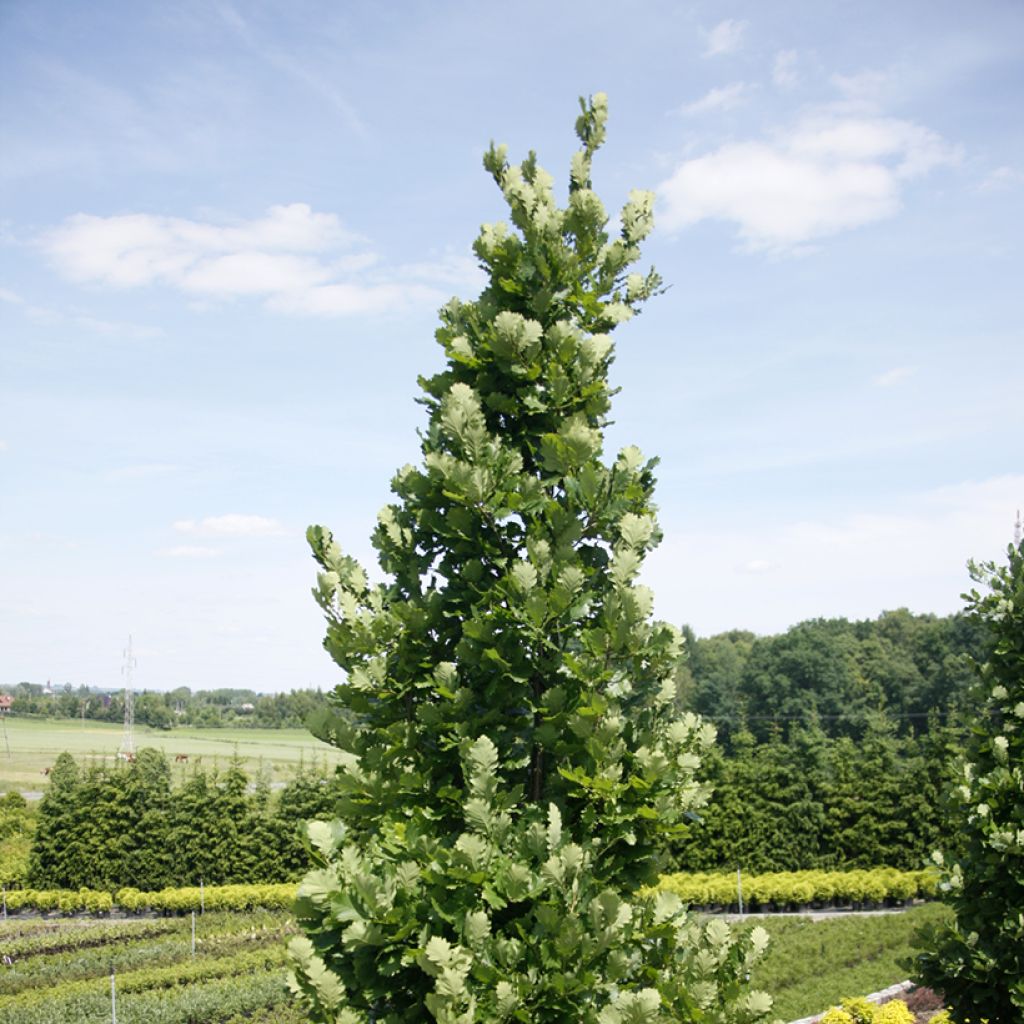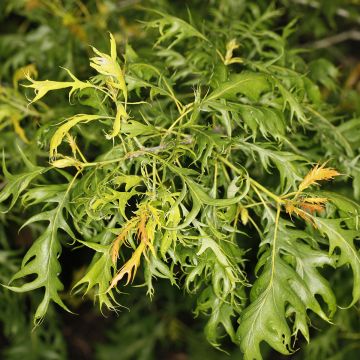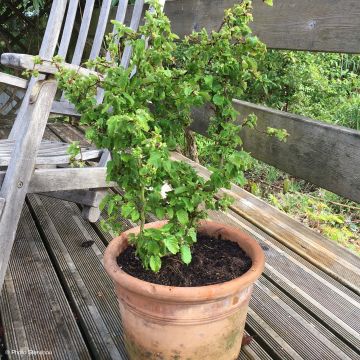

Quercus Monument - Oak


Quercus Monument - Oak
Quercus Monument - Oak
Quercus robur f. fastigiata x macrantera Monument
English Oak, Pedunculate Oak, European Oak
This item cannot be shipped to the selected country
Delivery charge from €5.90
More information
Schedule delivery date,
and select date in basket
This plant carries a 24 months recovery warranty
More information
We guarantee the quality of our plants for a full growing cycle, and will replace at our expense any plant that fails to recover under normal climatic and planting conditions.
From €5.90 for pickup delivery and €6.90 for home delivery
Express home delivery from €8.90.
Does this plant fit my garden?
Set up your Plantfit profile →
Description
The Quercus 'Monument' is one of the best varieties of columnar oak due to its harmonious habit and natural resistance to powdery mildew. Its foliage is particularly decorative and remains so until late in the season. With a dense, regular, and narrow crown, this tree expands slightly over time without losing its splendour. This oak is perfect as a standalone specimen, in rows, or as a hedge to create a windbreak. It is highly resistant to cold and can be easily grown in deep, fertile, and moist soil.
The 'Monument' oak is the result of a cross between the columnar pedunculate oak (Quercus robur 'Fastigiata') and the Caucasian oak (Quercus macranthera). It was created in 1984 at the botanical garden of Adama Mickiewicz University in Poznan, Poland, and was introduced to the market in 2009. At maturity, this tree reaches approximately 17.50 m in height with a spread of 4-5 m. The growth rate of this oak is moderate. Its habit is fastigiate, well-branched, supported by sturdy branches reaching towards the sky. The short trunk is initially green and smooth, then becomes grey, thick, and deeply fissured. The foliage of this variety consists of large, thick, leathery leaves measuring 18 cm long and 10 cm wide. They are ovoid in shape with lobed edges. The upper surface is a shiny dark green, while the underside appears lighter due to the presence of hairs. In autumn, the foliage turns from yellow to orange-brown. The leaves remain attached to the branches for a few weeks before falling. The flowering of the 'Monument' oak occurs in April-May, shortly after the appearance of the foliage, on annual shoots. The male inflorescences are elongated, pendulous catkins tinged with yellow. They are produced on older branches. The root system of this tree is deep and powerful, with both a taproot and extensive lateral roots, ensuring a strong and durable anchorage in deep and compact soils.
The 'Monument' oak is a beautiful ornamental tree if you have sufficient space. It can be planted as a standalone tree at the edge of a large garden open to the countryside, in rows along a wide and long avenue, or in a large grove with other native species such as black elder, European spindle, or guelder rose. This tree also has the advantage of producing abundant leaf litter, which is beneficial for the growth of certain plants that germinate under its canopy. This oak can also find its place in a large green curtain, combined with hornbeams, beech trees, or hazelnut trees, for example. Its fruits provide food for small animals such as squirrels and jays.
Report an error about the product description
Plant habit
Flowering
Foliage
Botanical data
Quercus
robur f. fastigiata x macrantera
Monument
Fagaceae
English Oak, Pedunculate Oak, European Oak
Cultivar or hybrid
Other Oak
Planting and care
The Quercus 'Monument' grows in any loose and deep soil, not too dry in summer. Once established, this tree with deep roots can withstand normal summers and requires no watering. This oak succeeds almost everywhere, except in coastal areas and in the dry and hot Mediterranean zone. It prefers very sunny and open exposures. Place a sturdy stake to help it get started, follow watering instructions, and then let nature take its course. Once established, this tree requires very little maintenance, except for removing dead wood. It is unaffected by diseases that affect the foliage of other oaks.
Planting period
Intended location
Care
This item has not been reviewed yet - be the first to leave a review about it.
Decoratively-shaped trees and shrubs
Haven't found what you were looking for?
Hardiness is the lowest winter temperature a plant can endure without suffering serious damage or even dying. However, hardiness is affected by location (a sheltered area, such as a patio), protection (winter cover) and soil type (hardiness is improved by well-drained soil).

Photo Sharing Terms & Conditions
In order to encourage gardeners to interact and share their experiences, Promesse de fleurs offers various media enabling content to be uploaded onto its Site - in particular via the ‘Photo sharing’ module.
The User agrees to refrain from:
- Posting any content that is illegal, prejudicial, insulting, racist, inciteful to hatred, revisionist, contrary to public decency, that infringes on privacy or on the privacy rights of third parties, in particular the publicity rights of persons and goods, intellectual property rights, or the right to privacy.
- Submitting content on behalf of a third party;
- Impersonate the identity of a third party and/or publish any personal information about a third party;
In general, the User undertakes to refrain from any unethical behaviour.
All Content (in particular text, comments, files, images, photos, videos, creative works, etc.), which may be subject to property or intellectual property rights, image or other private rights, shall remain the property of the User, subject to the limited rights granted by the terms of the licence granted by Promesse de fleurs as stated below. Users are at liberty to publish or not to publish such Content on the Site, notably via the ‘Photo Sharing’ facility, and accept that this Content shall be made public and freely accessible, notably on the Internet.
Users further acknowledge, undertake to have ,and guarantee that they hold all necessary rights and permissions to publish such material on the Site, in particular with regard to the legislation in force pertaining to any privacy, property, intellectual property, image, or contractual rights, or rights of any other nature. By publishing such Content on the Site, Users acknowledge accepting full liability as publishers of the Content within the meaning of the law, and grant Promesse de fleurs, free of charge, an inclusive, worldwide licence for the said Content for the entire duration of its publication, including all reproduction, representation, up/downloading, displaying, performing, transmission, and storage rights.
Users also grant permission for their name to be linked to the Content and accept that this link may not always be made available.
By engaging in posting material, Users consent to their Content becoming automatically accessible on the Internet, in particular on other sites and/or blogs and/or web pages of the Promesse de fleurs site, including in particular social pages and the Promesse de fleurs catalogue.
Users may secure the removal of entrusted content free of charge by issuing a simple request via our contact form.
The flowering period indicated on our website applies to countries and regions located in USDA zone 8 (France, the United Kingdom, Ireland, the Netherlands, etc.)
It will vary according to where you live:
- In zones 9 to 10 (Italy, Spain, Greece, etc.), flowering will occur about 2 to 4 weeks earlier.
- In zones 6 to 7 (Germany, Poland, Slovenia, and lower mountainous regions), flowering will be delayed by 2 to 3 weeks.
- In zone 5 (Central Europe, Scandinavia), blooming will be delayed by 3 to 5 weeks.
In temperate climates, pruning of spring-flowering shrubs (forsythia, spireas, etc.) should be done just after flowering.
Pruning of summer-flowering shrubs (Indian Lilac, Perovskia, etc.) can be done in winter or spring.
In cold regions as well as with frost-sensitive plants, avoid pruning too early when severe frosts may still occur.
The planting period indicated on our website applies to countries and regions located in USDA zone 8 (France, United Kingdom, Ireland, Netherlands).
It will vary according to where you live:
- In Mediterranean zones (Marseille, Madrid, Milan, etc.), autumn and winter are the best planting periods.
- In continental zones (Strasbourg, Munich, Vienna, etc.), delay planting by 2 to 3 weeks in spring and bring it forward by 2 to 4 weeks in autumn.
- In mountainous regions (the Alps, Pyrenees, Carpathians, etc.), it is best to plant in late spring (May-June) or late summer (August-September).
The harvesting period indicated on our website applies to countries and regions in USDA zone 8 (France, England, Ireland, the Netherlands).
In colder areas (Scandinavia, Poland, Austria...) fruit and vegetable harvests are likely to be delayed by 3-4 weeks.
In warmer areas (Italy, Spain, Greece, etc.), harvesting will probably take place earlier, depending on weather conditions.
The sowing periods indicated on our website apply to countries and regions within USDA Zone 8 (France, UK, Ireland, Netherlands).
In colder areas (Scandinavia, Poland, Austria...), delay any outdoor sowing by 3-4 weeks, or sow under glass.
In warmer climes (Italy, Spain, Greece, etc.), bring outdoor sowing forward by a few weeks.























































